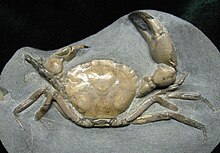Hoko River Formation
| Hoko River Formation Stratigraphic range: Late Eocene |
|
|---|---|

Branchioplax washingtoniana, Hoko River Formation
|
|
| Type | Geological formation |
| Unit of | Twin River Group |
| Underlies | Makah Formation sediments |
| Overlies | Lyre Formation sediments |
| Thickness | approximately 2,300 metres (7,550 ft) |
| Lithology | |
| Primary | submarine fan system |
| Location | |
| Region | Clallam County, Olympic Peninsula Washington |
| Country | United States |
| Extent | over 100 kilometres (62 mi) |
| Type section | |
| Named by | Snavely et al, 1978 |
The Hoko River Formation is a Late Eocene marine sedimentary geologic formation. The formation is exposed in outcrops along the Strait of Juan de Fuca on the Olympic Peninsula in Washington State, USA. It is known for containing numerous fossils of crabs. It overlies the older Lyre Formation and underlies the younger Makah Formation.
The Hoko River Formation consists of sediments deposited on the inner and middle slopes of a deep marine fan system. It is composed primarily of siltstones and some sandstones exposed under and to the south of the main Makah Formation outcrops along the Strait of Juan De Fuca. The type section, as designated by Parke Snavely et al., is a 1,600 metres (5,200 ft) section which outcrops along the Hoko River, for which the formation is named, and a 2,300 metres (7,500 ft) section which outcrops along Deep Creek. While the Hoko River formation overlies the Lyre Formation in many places, the two formations intertongue in others. The Makah and Hoko River formations are separated by a major unconformity. Calcareous clasts in the formation contain crab, gastropod, cephalopod, and wood fossils. Magnetostratigraphy performed in 2008 on samples taken from the type section of the Hoko River formation showed a correlation of age with either Chron C18r (40.0–41.2 Ma) or Chron C17r (38.0–38.2Ma). A closer correlation was not possible due to the limited sample size obtained for the testing. Of note is that the samples tested for both the Makah and Hoko River Formations showed a slight counterclockwise tectonic rotation. This is in contrast to many other formations of similar ages on the Olympic Peninsula with clockwise rotations. Similar results, however, from some formations on Vancouver Island and the northern Olympic Peninsula have been reported.
...
Wikipedia
